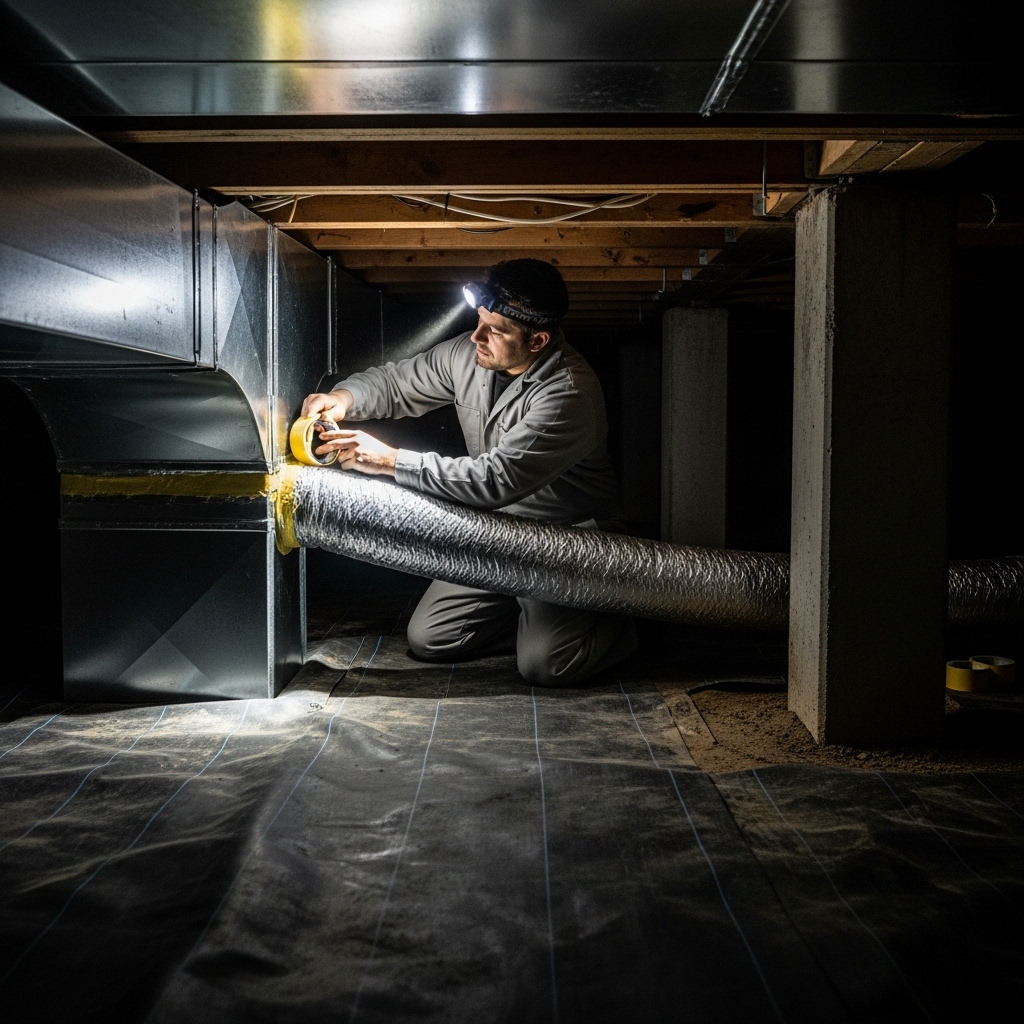Residential air duct replacement in Los Angeles feels like a behind-the-scenes project, but the difference it makes shows up in every room you live in. From early morning kitchen routines to late-night movie marathons, the comfort you feel depends on how smoothly air moves through the duct system and how well it is sealed against the heat, dust, and quirks of Southern California homes. Before you bring a crew into the attic or crawlspace, it helps to understand what a complete service includes and how the best teams in our city execute the work. A good starting point is to familiarize yourself with the principles of professional air duct replacement so you can visualize the process and the results.
Every neighborhood in Los Angeles tells its own story through the homes it holds. Bungalows from the 1920s, ranches from the 1960s, hillside contemporaries with dramatic lines—each house demands a slightly different approach. The ducts serving those spaces must navigate framing, insulation, and sometimes decades of remodel decisions. Residential services done well are tailored to these realities. They combine design expertise with installation discipline, producing systems that are efficient, quiet, and easy to live with day after day.
What a Residential Duct Replacement Service Really Covers
A comprehensive service starts with assessment. Technicians map out existing trunks and branches, note register locations, and verify the air handler’s position. They evaluate return air capacity, confirm duct insulation levels, and document access constraints. Photographs and measurements guide both the design and the staging of materials so crews arrive prepared. This front-loading of effort pays dividends later, when installers move efficiently and adapt confidently to field conditions.
Design is the second pillar. Good contractors refine duct sizes to match room loads, balancing branches so bedrooms, living spaces, and kitchens receive the right airflow. They identify chronic hot or cold spots and correct them, not by over-supplying air but by sizing and routing wisely. They also address return air, which is often undersized in older homes. Creating a quiet, adequately sized return path relieves strain on equipment and improves filtration.
Materials and Sealing That Stand Up to Los Angeles Conditions
Materials matter in our climate. Attic heat and coastal air demand sturdy solutions. Many residential projects rely on a hybrid approach: rigid trunks for durability and acoustics, flexible branches for controlled routing and vibration reduction. Insulation levels are chosen to resist attic temperatures, and all connections are sealed with mastic and UL-rated tapes. Boots are sealed to ceilings or floors to prevent air from pulling dusty attic air into living spaces. The result is a system that not only passes a test but feels solid and quiet.
Sealing goes hand in hand with support. Proper hangers and straps prevent sagging, preserve airflow, and protect insulation integrity. Spacing supports correctly and avoiding sharp bends keeps friction losses low and noise at bay. These are the details you rarely see, but you experience them every day in the way your home holds its temperature and the way the system sounds—or does not sound—when it runs.
Access, Safety, and Respect for Your Home
Residential services occur in lived-in spaces, which means protection matters. Crews lay down coverings, isolate work areas, and maintain clean pathways. In attics, they work from safe platforms or temporary walkways to protect drywall and insulation. In crawlspaces, they take precautions against moisture and debris. The goal is to finish the day with your home as tidy as it began, with only the attic or crawlspace telling the story of big changes.
Safety extends to scheduling and communication. Reliable teams arrive on time, explain the day’s plan, and check in when field conditions require adjustments. You should feel informed but not overwhelmed. If a return needs resizing or a branch route could be improved, they will show you, not just tell you, so you can approve changes with confidence.
Integration With Energy Codes and Inspection
Residential projects in California frequently involve permits and performance checks. Planning for these from the outset saves headaches later. That means selecting materials and methods that predictably deliver low duct leakage and proper airflow. By the time inspectors and HERS raters arrive, the system should be ready to perform, not patched together at the last moment. Homeowners may never see the mastic inside a plenum or the way a takeoff is crimped and sealed, but inspectors will—and so will your future self when you enjoy a quiet, efficient system year after year.
One benefit of aligning with codes is consistency. A system built to meet performance standards is a system built to protect comfort as the seasons change. In a city where summer can outstay its welcome, that consistency adds up to a calmer, more enjoyable home environment.
What Installation Days Look Like
On installation day one, crews usually remove old ductwork, set protection, and stage new materials. They verify measurements and begin main trunk routing, making any necessary adjustments to fit the real attic or crawlspace geometry. Branches are added with attention to length, bends, and support spacing. Connections are sealed as they go, not at the end, to ensure consistency.
Midway through, a quality team performs internal checkpoints. They listen for air noise, confirm damper position, and adjust branches before insulation is finalized. They ensure returns are quiet and adequate. These steps prevent last-minute compromises and guard the design intent that guided the initial plan. If you want to recognize these habits, review the fundamentals of air duct replacement so you can spot them in your own attic walk-through.
After the Work: Testing, Balancing, and Homeowner Orientation
Once ducts are in place, testing and balancing confirm performance. Duct leakage is verified, airflow is measured or qualitatively balanced at registers, and the crew documents key components with photos. A homeowner walkthrough follows, where installers point out trunks, branches, and dampers, explain maintenance basics, and answer questions about comfort across rooms and times of day.
After you settle in with the new system, you should notice even temperatures, quieter operation, and the feeling that the home is easier to live in. Filters catch more, dust lingers less, and the system cycles more predictably. These are the quiet victories of a residential service handled with care.
When Replacement Reveals Additional Opportunities
Sometimes duct replacement uncovers chances to improve other parts of the system. Upgrading return grilles, addressing leaky boot-to-drywall connections, or refining register placement can have outsized benefits. Good teams discuss these options transparently, presenting practical solutions that fit your goals for comfort, appearance, and long-term reliability.
In homes with additions or partial remodels, residential services can tie together disparate zones. A smart branch to a room that always lagged behind can eliminate daily frustration. A better return path can quiet a noisy hallway. These tweaks may be small in scope but large in impact.
Longevity and Care
Like any part of a home, ducts benefit from periodic attention. Replace filters on schedule, observe how rooms feel during heat waves, and keep attic or crawlspace access clear for future service. If you hear new noises or sense a change in comfort, a quick check can catch small issues before they grow. A system installed with quality materials and methods should provide years of dependable service, and basic care helps it do just that.
The Residential Difference: People and Process
Residential work happens in the middle of family life. The crews who excel in this space understand that their job includes courtesy and empathy. They move carefully, communicate clearly, and take pride in leaving your home better than they found it. The process matters as much as the product because, for a few days, your home is their jobsite and their reputation is built in every interaction.
Frequently Asked Questions
How do residential services differ from commercial duct projects?
Residential projects are tailored to lived-in spaces, with an emphasis on comfort, noise control, and protection of interiors. Access constraints, family schedules, and aesthetics all play bigger roles than in many commercial jobs.
Do I need to be home during installation?
Not necessarily, but being available at key moments—start of day, mid-project check-ins, and the final walkthrough—helps ensure the outcome matches your expectations and allows quick decisions when field conditions suggest improvements.
How do I know if my ducts truly need replacement?
Persistent comfort problems, visible damage, excessive dust, and noise are common signs. A professional assessment that includes measurements and a design review can clarify whether targeted repairs or full replacement will serve you best.
What materials should I expect in a quality residential installation?
Often a mix of rigid metal trunks and insulated flexible branches, sealed with mastic and UL-rated tapes, supported at proper intervals, and insulated to levels suitable for Los Angeles attics or crawlspaces.
Will new ducts make my home more comfortable?
Yes. Balanced airflow, improved returns, and careful sealing translate to steadier temperatures, quieter operation, and better indoor air quality.
Are permits and tests part of the process?
Many residential projects include permits and performance verification such as duct leakage tests. Reputable teams plan for these requirements from the start.
How long does a typical residential replacement take?
Timeframes vary with access, home layout, and scope, but many single-system homes are completed within a focused schedule measured in days, with larger or more complex homes taking longer.
What should I do to prepare my home?
Clear pathways to attic hatches or crawlspace entries, relocate items stored near access points, and note rooms with consistent comfort issues so the design can target those areas.
Ready for a quieter, more comfortable home?
If you are considering residential duct replacement, choose a team that treats design and sealing as non-negotiable. When you are ready, explore professional air duct replacement to map a plan for your home and turn everyday living into a consistently comfortable experience.

